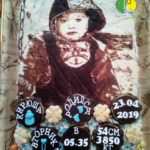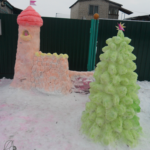I continue a series of short articles, where I have a few photos of crafts, but I really want to share them with my readers. For those who have not seen my previous posts, I want to clarify that these photos were lost due to the brutal war that Russia unleashed on the territory of Ukraine. I had a whole series of photos with step-by-step instructions, unfortunately, everything was destroyed. But still, this Egyptian cat deserves to be shown to you, even if only a few photos remain.
So after I made the tiger I found that sometimes it is very difficult to sculpt small details from concrete. If you missed the article about the tiger you can click here. Therefore, it was decided to mold a figurine from plasticine, make a silicone mold based on it, and then cast a figurine from concrete from the finished silicone mold. To save on plasticine, I took a small plastic juice bottle and put plasticine on top of it. Initially, I wanted to make an ordinary fluffy cat. But as often happens with creative people, you start doing one thing, and something else comes out. To my surprise, I got an Egyptian cat. All attempts to mold an ordinary cat were unsuccessful, but when I gave up and continued to mold the Egyptian cat, the work went easily and very quickly. This is what I ended up with.

Plasticine is a very flexible material that holds its shape well and allows you to sculpt small details. I can’t remember what kind of silicone I used, but it was inexpensive two-component silicone for sculptures. I applied at least 5 layers of silicone one after the previous one dried. The mold consisted of 2 parts. Part 1 is a silicone mold that was divided in half. Part 2 is a hard mold made of epoxy resin and fiberglass that exactly replicates the silicone mold. This was done so that the mold would not deform during the production of the figurine. For small figurines, molds are made entirely of silicone. For large figures, this would be very expensive and unprofitable. Therefore, I preferred the 2-part option.

This is the Egyptian cat I made from concrete. But during the production process, I discovered that it needed a vibration table. My sculpture had visible frozen air bubbles that had to be masked. To avoid this problem, special vibration tables are used in production. The cat weighed 2.5 kilograms, I dried it, covered it with a primer, painted it with white water-based paint for outdoor use, painted it with acrylic paints on top and covered it with ship varnish. As a result, I got a unique experience with silicone molds. This allows to get up to 100 copies. Several of these Egyptian cats became gifts for my friends.
Unfortunately, the silicone mold, like these concrete cats, and the step-by-step photos were lost forever.














